Underground Ink: Printed Electronics Enabling Electrochemical Sensing in Soil
Abstract
1. Introduction
2. Printed Electrochemical Sensors for Soil Sensing
2.1. Potentiometric Sensors
2.2. Voltametric Sensors
2.2.1. Cyclic Voltammetry
2.2.2. Anodic Stripping Voltammetry
2.3. Amperometric Sensors
2.4. Impedimetric Sensors
2.5. Other Sensors
3. Peripheral Electronics for Measurement and Monitoring
3.1. Data Communication and Transmission
3.2. Power Management for Soil Sensors
3.3. Energy Integration Platform
4. Printed Soil Sensors: Emerging Trends and Outlook
4.1. Overview of the Soil Sensor Market
4.2. Emerging Demands in Agricultural Applications
4.3. Remaining Challenges for Printed Soil Sensors
5. Conclusions
Author Contributions
Funding
Conflicts of Interest
References
- Candemir, A.; Duvaleix, S.; Latruffe, L. Agricultural Cooperatives and Farm Sustainability–A Literature Review. J. Econ. Surv. 2021, 35, 1118–1144. [Google Scholar] [CrossRef]
- Peng, B.; Guan, K.; Tang, J.; Ainsworth, E.A.; Asseng, S.; Bernacchi, C.J.; Cooper, M.; Delucia, E.H.; Elliott, J.W.; Ewert, F. Towards a Multiscale Crop Modelling Framework for Climate Change Adaptation Assessment. Nat. Plants 2020, 6, 338–348. [Google Scholar] [CrossRef]
- Snowdon, R.J.; Wittkop, B.; Chen, T.-W.; Stahl, A. Crop Adaptation to Climate Change as a Consequence of Long-Term Breeding. Theor. Appl. Genet. 2021, 134, 1613–1623. [Google Scholar] [CrossRef]
- Akkem, Y.; Biswas, S.K.; Varanasi, A. Smart Farming Using Artificial Intelligence: A Review. Eng. Appl. Artif. Intell. 2023, 120, 105899. [Google Scholar] [CrossRef]
- Fan, Y.; Wang, X.; Funk, T.; Rashid, I.; Herman, B.; Bompoti, N.; Mahmud, M.D.S.; Chrysochoou, M.; Yang, M.; Vadas, T.M. A Critical Review for Real-Time Continuous Soil Monitoring: Advantages, Challenges, and Perspectives. Environ. Sci. Technol. 2022, 56, 13546–13564. [Google Scholar] [CrossRef]
- Borghetti, M.; Cantù, E.; Sardini, E.; Serpelloni, M. Future Sensors for Smart Objects by Printing Technologies in Industry 4.0 Scenario. Energies 2020, 13, 5916. [Google Scholar] [CrossRef]
- Barrile, V.; Simonetti, S.; Citroni, R.; Fotia, A.; Bilotta, G. Experimenting Agriculture 4.0 with Sensors: A Data Fusion Approach between Remote Sensing, UAVs and Self-Driving Tractors. Sensors 2022, 22, 7910. [Google Scholar] [CrossRef]
- Lloret, J.; Sendra, S.; Garcia, L.; Jimenez, J.M. A Wireless Sensor Network Deployment for Soil Moisture Monitoring in Precision Agriculture. Sensors 2021, 21, 7243. [Google Scholar] [CrossRef]
- Placidi, P.; Morbidelli, R.; Fortunati, D.; Papini, N.; Gobbi, F.; Scorzoni, A. Monitoring Soil and Ambient Parameters in the Iot Precision Agriculture Scenario: An Original Modeling Approach Dedicated to Low-Cost Soil Water Content Sensors. Sensors 2021, 21, 5110. [Google Scholar] [CrossRef] [PubMed]
- Gopalakrishnan, S.; Waimin, J.; Zareei, A.; Sedaghat, S.; Raghunathan, N.; Shakouri, A.; Rahimi, R. A Biodegradable Chipless Sensor for Wireless Subsoil Health Monitoring. Sci. Rep. 2022, 12, 8011. [Google Scholar] [CrossRef] [PubMed]
- Rosa, P.; Câmara, A.; Gouveia, C. The Potential of Printed Electronics and Personal Fabrication in Driving the Internet of Things. OJIOT 2015, 1, 16–36. [Google Scholar]
- Schnittker, K.; Tursunniyaz, M.; Andrews, J.B. Recent Advances in Printable Carbon Nanotube Transistors for Large-Area Active Matrices. J. Inf. Disp. 2021, 22, 193–209. [Google Scholar] [CrossRef]
- Cao, X.; Lau, C.; Liu, Y.; Wu, F.; Gui, H.; Liu, Q.; Ma, Y.; Wan, H.; Amer, M.R.; Zhou, C. Fully Screen-Printed, Large-Area, and Flexible Active-Matrix Electrochromic Displays Using Carbon Nanotube Thin-Film Transistors. ACS Nano 2016, 10, 9816–9822. [Google Scholar] [CrossRef]
- Wang, X.; Wei, M.; Li, X.; Shao, S.; Ren, Y.; Xu, W.; Li, M.; Liu, W.; Liu, X.; Zhao, J. Large-Area Flexible Printed Thin-Film Transistors with Semiconducting Single-Walled Carbon Nanotubes for NO2Sensors. ACS Appl. Mater. Interfaces 2020, 12, 51797–51807. [Google Scholar] [CrossRef]
- Jung, Y.; Park, H.; Park, J.A.; Noh, J.; Choi, Y.; Jung, M.; Jung, K.; Pyo, M.; Chen, K.; Javey, A.; et al. Fully Printed Flexible and Disposable Wireless Cyclic Voltammetry Tag. Sci. Rep. 2015, 5, 8105. [Google Scholar] [CrossRef]
- Andrews, J.B.; Cardenas, J.A.; Mullett, J.; Franklin, A.D. Fully Printed and Flexible Carbon Nanotube Transistors Designed for Environmental Pressure Sensing and Aimed at Smart Tire Applications. In Proceedings of the IEEE Sensors, Glasgow, UK, 29 October–1 November 2017. [Google Scholar] [CrossRef]
- Subramanian, V.; Chang, J.B.; De La Fuente Vornbrock, A.; Huang, D.C.; Jagannathan, L.; Liao, F.; Mattis, B.; Molesa, S.; Redinger, D.R.; Soltman, D.; et al. Printed Electronics for Low-Cost Electronic Systems: Technology Status and Application Development. In Proceedings of the ESSCIRC 2008—34th European Solid-State Circuits Conference, Edinburgh, UK, 15–19 September 2008; pp. 17–24. [Google Scholar] [CrossRef]
- Khan, Y.; Thielens, A.; Muin, S.; Ting, J.; Baumbauer, C.; Arias, A.C. A New Frontier of Printed Electronics: Flexible Hybrid Electronics. Adv. Mater. 2020, 32, e1905279. [Google Scholar] [CrossRef] [PubMed]
- Rayhana, R.; Xiao, G.G.; Liu, Z. Printed Sensor Technologies for Monitoring Applications in Smart Farming: A Review. IEEE Trans. Instrum. Meas. 2021, 70, 9513419. [Google Scholar] [CrossRef]
- Nadporozhskaya, M.; Kovsh, N.; Paolesse, R.; Lvova, L. Recent Advances in Chemical Sensors for Soil Analysis: A Review. Chemosensors 2022, 10, 35. [Google Scholar] [CrossRef]
- Barhoum, A.; Hamimed, S.; Slimi, H.; Othmani, A.; Abdel-Haleem, F.M.; Bechelany, M. Modern Designs of Electrochemical Sensor Platforms for Environmental Analyses: Principles, Nanofabrication Opportunities, and Challenges. Tren. Environ. Anal. Chem. 2023, 38, e00199. [Google Scholar] [CrossRef]
- Rubino, A.; Queirós, R. Electrochemical Determination of Heavy Metal Ions Applying Screen-Printed Electrodes Based Sensors. A Review on Water and Environmental Samples Analysis. Talanta Open 2023, 7, 100203. [Google Scholar] [CrossRef]
- Chen, S.; Chen, J.; Qian, M.; Liu, J.; Fang, Y. Low Cost, Portable Voltammetric Sensors for Rapid Detection of Nitrate in Soil. Electrochim. Acta 2023, 446, 142077. [Google Scholar] [CrossRef]
- Sophocleous, M.; Karkotis, A.; Papasavva, A.; Goldberger, M.; Vassiliou, L.; Ros-Lis, J.V.; Shacham-Diamand, Y.; Georgiou, J. A Stand-Alone, In Situ, Soil Quality Sensing System for Precision Agriculture. IEEE Trans. AgriFood Electron. 2024, 2, 43–50. [Google Scholar] [CrossRef]
- Jiang, H.; Yu, W.; Waimin, J.F.; Glassmaker, N.; Raghunathan, N.; Jiang, X.; Ziaie, B.; Rahimi, R. Inkjet-Printed Solid-State Potentiometric Nitrate Ion Selective Electrodes for Agricultural Application. In Proceedings of the 2019 IEEE SENSORS, Montreal, QC, Canada, 27–30 October 2019; pp. 1–4. [Google Scholar]
- Chen, K.-Y.; Biswas, A.; Cai, S.; Huang, J.; Andrews, J. Inkjet Printed Potentiometric Sensors for Nitrate Detection Directly in Soil Enabled by a Hydrophilic Passivation Layer. Adv. Mater. Technol. 2024, 2301140. [Google Scholar] [CrossRef]
- Soga, T.; Jimbo, Y.; Suzuki, K.; Citterio, D. Inkjet-Printed Paper-Based Colorimetric Sensor Array for the Discrimination of Volatile Primary Amines. Anal. Chem. 2013, 85, 8973–8978. [Google Scholar] [CrossRef] [PubMed]
- Yin, H.; Cao, Y.; Marelli, B.; Zeng, X.; Mason, A.J.; Cao, C. Soil Sensors and Plant Wearables for Smart and Precision Agriculture. Adv. Mater. 2021, 33, 2007764. [Google Scholar] [CrossRef] [PubMed]
- Zdrachek, E.; Bakker, E. Potentiometric Sensing. Anal. Chem. 2019, 91, 2–26. [Google Scholar] [CrossRef] [PubMed]
- Hu, J.; Stein, A.; Bühlmann, P. Rational Design of All-Solid-State Ion-Selective Electrodes and Reference Electrodes. TrAC Trends Anal. Chem. 2016, 76, 102–114. [Google Scholar] [CrossRef]
- Ryu, H.; Thompson, D.; Huang, Y.; Li, B.; Lei, Y. Electrochemical Sensors for Nitrogen Species: A Review. Sens. Actuators Rep. 2020, 2, 100022. [Google Scholar] [CrossRef]
- Bühlmann, P.; Chen, L.D. Ion-Selective Electrodes with Ionophore-Doped Sensing Membranes. Supramol. Chem. Mol. Nanomater. 2012, 5, 2539. [Google Scholar]
- Bobacka, J.; Ivaska, A.; Lewenstam, A. Potentiometric Ion Sensors. Chem. Rev. 2008, 108, 329–351. [Google Scholar] [CrossRef]
- Jin, X.; Saha, A.; Jiang, H.; Oduncu, M.R.; Yang, Q.; Sedaghat, S.; Maize, K.; Allebach, J.P.; Shakouri, A.; Glassmaker, N. Steady-State and Transient Performance of Ion-Sensitive Electrodes Suitable for Wearable and Implantable Electro-Chemical Sensing. IEEE Trans. Biomed. Eng. 2021, 69, 96–107. [Google Scholar] [CrossRef]
- Cranny, A.; Harris, N.R.; White, N.M.; Barrett-Lennard, E.; Coles, N.; Rivers, M.; Smettem, K.; Wu, J. Screen-Printed Potentiometric Sensors for Chloride Measurement in Soils. Procedia Eng. 2012, 47, 1157–1160. [Google Scholar] [CrossRef][Green Version]
- Lin, J.; Wang, M.; Zhang, M.; Zhang, Y.; Chen, L. Electrochemical Sensors for Soil Nutrient Detection: Opportunity and Challenge. In Proceedings of the Computer and Computing Technologies in Agriculture, Volume II: First IFIP TC 12 International Conference on Computer and Computing Technologies in Agriculture (CCTA 2007), Wuyishan, China, 18–20 August 2007; Springer: Berlin/Heidelberg, Germany, 2008; pp. 1349–1353. [Google Scholar]
- Khoshnood, R.S.; Fakhrabad, A.H.; Abedi, M.R.; Ebrahimi, M. Sensitive and Selective Potentiometric Sensor Based on Carbon Paste Electrode for Determining Cerium (III) Ions in Soil and Water Samples; Simplex Lattice Mixture Design Application. Anal. Bioanal. Electrochem. 2022, 14, 953–967. [Google Scholar]
- Garland, N.T.; McLamore, E.S.; Cavallaro, N.D.; Mendivelso-Perez, D.; Smith, E.A.; Jing, D.; Claussen, J.C. Flexible Laser-Induced Graphene for Nitrogen Sensing in Soil. ACS Appl. Mater. Interfaces 2018, 10, 39124–39133. [Google Scholar] [CrossRef]
- Ali, M.A.; Wang, X.; Chen, Y.; Jiao, Y.; Mahal, N.K.; Moru, S.; Castellano, M.J.; Schnable, J.C.; Schnable, P.S.; Dong, L. Continuous Monitoring of Soil Nitrate Using a Miniature Sensor with Poly (3-Octyl-Thiophene) and Molybdenum Disulfide Nanocomposite. ACS Appl. Mater. Interfaces 2019, 11, 29195–29206. [Google Scholar] [CrossRef]
- El-Beshlawy, M.M.; Abdel-Haleem, F.M.; Kamel, A.H.; Barhoum, A. Screen-Printed Sensors Coated with Polyaniline/Molecularly Imprinted Polymer Membranes for the Potentiometric Determination of 2,4-Dichlorophenoxyacetic Acid Herbicide in Wastewater and Agricultural Soil. Chemosensors 2023, 11, 3. [Google Scholar] [CrossRef]
- Baumbauer, C.L.; Goodrich, P.J.; Payne, M.E.; Anthony, T.; Beckstoffer, C.; Toor, A.; Silver, W.; Arias, A.C. Printed Potentiometric Nitrate Sensors for Use in Soil. Sensors 2022, 22, 4095. [Google Scholar] [CrossRef]
- Lemos, S.G.; Nogueira, A.R.A.; Torre-Neto, A.; Parra, A.; Artigas, J.; Alonso, J. In-Soil Potassium Sensor System. J. Agric. Food Chem. 2004, 52, 5810–5815. [Google Scholar] [CrossRef]
- Polidori, G.; Tonello, S.; Serpelloni, M. Ion-Selective All-Solid-State Printed Sensors: A Systematic Review. IEEE Sens. J. 2024, 24, 7375–7394. [Google Scholar] [CrossRef]
- Mohan, J.M.; Amreen, K.; Kulkarni, M.B.; Javed, A.; Dubey, S.K.; Goel, S. Optimized Ink Jetted Paper Device for Electroanalytical Detection of Picric Acid. Colloids Surf. B Biointerfaces 2021, 208, 112056. [Google Scholar] [CrossRef]
- Zhu, Y.; Chen, Y.; Ali, M.A.; Dong, L.; Wang, X.; Archontoulis, S.V.; Schnable, J.C.; Castellano, M.J. Continuous in Situ Soil Nitrate Sensors: The Importance of High-resolution Measurements across Time and a Comparison with Salt Extraction-based Methods. Soil. Sci. Soc. Am. J. 2021, 85, 677–690. [Google Scholar] [CrossRef]
- Chen, A.; Shah, B. Electrochemical Sensing and Biosensing Based on Square Wave Voltammetry. Anal. Methods 2013, 5, 2158–2173. [Google Scholar] [CrossRef]
- Kundu, M.; Krishnan, P.; Chobhe, K.A.; Manjaiah, K.M.; Pant, R.P.; Chawla, G. Fabrication of Electrochemical Nanosensor for Detection of Nitrate Content in Soil Extract. J. Soil. Sci. Plant Nutr. 2022, 22, 2777–2792. [Google Scholar] [CrossRef]
- Yin, S.; Tursunniyaz, M.; Huang, J.; Andrews, J. Dual-Printed Soil Sensors for Nitrate and Moisture Monitoring. In Proceedings of the IEEE Sensors, Sydney, Australia, 31 October–3 November 2021; Institute of Electrical and Electronics Engineers Inc.: Piscataway, NJ, USA, 2021; Volume 2021-October. [Google Scholar]
- Gurban, A.M.; Zamfir, L.G.; Epure, P.; Șuică-Bunghez, I.R.; Senin, R.M.; Jecu, M.L.; Jinga, M.L.; Doni, M. Flexible Miniaturized Electrochemical Sensors Based on Multiwalled Carbon Nanotube-Chitosan Nanomaterial for Determination of Nitrite in Soil Solutions. Chemosensors 2023, 11, 224. [Google Scholar] [CrossRef]
- Pal, A.; Amreen, K.; Dubey, S.K.; Goel, S. Highly Sensitive and Interference-Free Electrochemical Nitrite Detection in a 3D Printed Miniaturized Device. IEEE Trans. Nanobioscience 2021, 20, 175–182. [Google Scholar] [CrossRef]
- Lu, Y.; Lan, Q.; Zhang, C.; Liu, B.; Wang, X.; Xu, X.; Liang, X. Trace-Level Sensing of Phosphate for Natural Soils by a Nano-Screen-Printed Electrode. Environ. Sci. Technol. 2021, 55, 13093–13102. [Google Scholar] [CrossRef]
- Tang, C.; Fu, D.; Wang, R.; Zhang, X.; Wei, L.; Li, M.; Li, C.; Cao, Q.; Chen, X. An Electrochemical Microfluidic System for On-Site Continuous Monitoring of Soil Phosphate. IEEE Sens. J. 2024, 24, 6754–6764. [Google Scholar] [CrossRef]
- Cioffi, A.; Mancini, M.; Gioia, V.; Cinti, S. Office Paper-Based Electrochemical Strips for Organophosphorus Pesticide Monitoring in Agricultural Soil. Environ. Sci. Technol. 2021, 55, 8859–8865. [Google Scholar] [CrossRef]
- Bhandari, S.; Singh, U.; Kumbhat, S. Nafion-Modified Carbon Based Sensor for Soil Potassium Detection. Electroanalysis 2019, 31, 813–819. [Google Scholar] [CrossRef]
- Zhang, D.; Ding, J.; Zhang, D.; Liu, Y.; Yu, M.; Zhan, X.; Zhou, P. An Electrochemical Aptasensor for Detection of Lead Ions Using a Screen-Printed Carbon Electrode Modified with Au/Polypyrrole Composites and Toluidine Blue. Anal. Methods 2019, 11, 4274–4279. [Google Scholar] [CrossRef]
- Kadara, R.O.; Tothill, I.E. Development of Disposable Bulk-Modified Screen-Printed Electrode Based on Bismuth Oxide for Stripping Chronopotentiometric Analysis of Lead (II) and Cadmium (II) in Soil and Water Samples. Anal. Chim. Acta 2008, 623, 76–81. [Google Scholar] [CrossRef] [PubMed]
- Faucher, S.; Cugnet, C.; Authier, L.; Lespes, G. Speciation of Copper in Agricultural Soils Contaminated by Lead Using Screen-Printed Electrodes and Square-Wave Anodic Stripping Voltammetry (SPE-SWASV). Anal. Methods 2014, 6, 7942–7950. [Google Scholar] [CrossRef]
- Cinti, S.; Santella, F.; Moscone, D.; Arduini, F. Hg2+ Detection Using a Disposable and Miniaturized Screen-Printed Electrode Modified with Nanocomposite Carbon Black and Gold Nanoparticles. Environ. Sci. Pollut. Res. 2016, 23, 8192–8199. [Google Scholar] [CrossRef]
- Lv, H.; Zhang, G.; Yang, W.; Dai, X.; Huang, Y.; Ni, J.; Wang, Q. Portable Anti-Fouling Electrochemical Sensor for Soil Heavy Metal Ions Detection Based on the Screen-Printed Carbon Electrode Modified with Silica Isoporous Membrane. J. Electroanal. Chem. 2023, 930, 117141. [Google Scholar] [CrossRef]
- Wang, Z.; Sun, X.; Li, C.; He, X.; Liu, G. On-Site Detection of Heavy Metals in Agriculture Land by a Disposable Sensor Based Virtual Instrument. Comput. Electron. Agric. 2016, 123, 176–183. [Google Scholar] [CrossRef]
- Lu, Y.; Liang, X.; Niyungeko, C.; Zhou, J.; Xu, J.; Tian, G. A Review of the Identification and Detection of Heavy Metal Ions in the Environment by Voltammetry. Talanta 2018, 178, 324–338. [Google Scholar] [CrossRef] [PubMed]
- Elgrishi, N.; Rountree, K.J.; McCarthy, B.D.; Rountree, E.S.; Eisenhart, T.T.; Dempsey, J.L. A Practical Beginner’s Guide to Cyclic Voltammetry. J. Chem. Educ. 2018, 95, 197–206. [Google Scholar] [CrossRef]
- Rafiee, M.; Abrams, D.J.; Cardinale, L.; Goss, Z.; Romero-Arenas, A.; Stahl, S.S. Cyclic Voltammetry and Chronoamperometry: Mechanistic Tools for Organic Electrosynthesis. Chem. Soc. Rev. 2024, 53, 566–585. [Google Scholar] [CrossRef] [PubMed]
- Lin, P.; Chai, F.; Zhang, R.; Xu, G.; Fan, X.; Luo, X. Electrochemical Synthesis of Poly(3,4-Ethylenedioxythiophene) Doped with Gold Nanoparticles, and Its Application to Nitrite Sensing. Microchim. Acta 2016, 183, 1235–1241. [Google Scholar] [CrossRef]
- Fan, X.; Lin, P.; Liang, S.; Hui, N.; Zhang, R.; Feng, J.; Xu, G. Gold Nanoclusters Doped Poly(3,4-Ethylenedioxythiophene) for Highly Sensitive Electrochemical Sensing of Nitrite. Ionics 2017, 23, 997–1003. [Google Scholar] [CrossRef]
- Ivanišević, I. The Role of Silver Nanoparticles in Electrochemical Sensors for Aquatic Environmental Analysis. Sensors 2023, 23, 3692. [Google Scholar] [CrossRef] [PubMed]
- Xu, K.; Pérez-Ràfols, C.; Marchoud, A.; Cuartero, M.; Crespo, G.A. Anodic Stripping Voltammetry with the Hanging Mercury Drop Electrode for Trace Metal Detection in Soil Samples. Chemosensors 2021, 9, 107. [Google Scholar] [CrossRef]
- Borrill, A.J.; Reily, N.E.; Macpherson, J. V Addressing the Practicalities of Anodic Stripping Voltammetry for Heavy Metal Detection: A Tutorial Review. Analyst 2019, 144, 6834–6849. [Google Scholar] [CrossRef]
- Sawan, S.; Maalouf, R.; Errachid, A.; Jaffrezic-Renault, N. Metal and Metal Oxide Nanoparticles in the Voltammetric Detection of Heavy Metals: A Review. TrAC Trends Anal. Chem. 2020, 131, 116014. [Google Scholar] [CrossRef]
- Nadumane, S.S.; Biswas, R.; Mazumder, N. Integrated Microfluidic Platforms for Heavy Metal Sensing: A Comprehensive Review. Anal. Methods 2024. [Google Scholar] [CrossRef] [PubMed]
- Haddour, N.; Azri, Y.M. Recent Advances on Electrochemical Sensors Based on Electroactive Bacterial Systems for Toxicant Monitoring: A Minireview. Electroanalysis 2023, 35, e202200202. [Google Scholar] [CrossRef]
- Amine, A.; Mohammadi, H. Amperometry☆. In Encyclopedia of Analytical Science, 3rd ed.; Worsfold, P., Poole, C., Townshend, A., Miró, M., Eds.; Academic Press: Oxford, UK, 2019; pp. 85–98. ISBN 978-0-08-101984-9. [Google Scholar]
- Davis, G. Electrochemical Techniques for the Development of Amperometric Biosensors. Biosensors 1985, 1, 161–178. [Google Scholar] [CrossRef]
- Albery, W.J.; Bartlett, P.N.; Cass, A.E.G. Amperometric Enzyme Electrodes. Philos. Trans. R. Soc. Lond. B Biol. Sci. 1987, 316, 107–119. [Google Scholar] [PubMed]
- Bollella, P.; Gorton, L. Enzyme Based Amperometric Biosensors. Curr. Opin. Electrochem. 2018, 10, 157–173. [Google Scholar] [CrossRef]
- Guerrieri, A.; Monaci, L.; Quinto, M.; Palmisano, F. A Disposable Amperometric Biosensor for Rapid Screening of Anticholinesterase Activity in Soil Extracts. Analyst 2002, 127, 5–7. [Google Scholar] [CrossRef]
- Sok, V.; Fragoso, A. Amperometric Biosensor for Glyphosate Based on the Inhibition of Tyrosinase Conjugated to Carbon Nano-Onions in a Chitosan Matrix on a Screen-Printed Electrode. Microchim. Acta 2019, 186, 569. [Google Scholar] [CrossRef]
- Couto, R.A.S.; Lima, J.L.F.C.; Quinaz, M.B. Recent Developments, Characteristics and Potential Applications of Screen-Printed Electrodes in Pharmaceutical and Biological Analysis. Talanta 2016, 146, 801–814. [Google Scholar] [CrossRef] [PubMed]
- Allen, J.B.; Larry, R. Faulkner Electrochemical Methods: Fundamentals and Applications, 2nd ed.; Wiley: New York, NY, USA, 2001. [Google Scholar]
- Guan, J.-G.; Miao, Y.-Q.; Zhang, Q.-J. Impedimetric Biosensors. J. Biosci. Bioeng. 2004, 97, 219–226. [Google Scholar] [CrossRef]
- Eldeeb, M.A.; Dhamu, V.N.; Paul, A.; Muthukumar, S.; Prasad, S. Electrochemical Soil Nitrate Sensor for In Situ Real-Time Monitoring. Micromachines 2023, 14, 1314. [Google Scholar] [CrossRef] [PubMed]
- Eldeeb, M.A.; Dhamu, V.N.; Paul, A.; Muthukumar, S.; Prasad, S. Espial: Electrochemical Soil PH Sensor for In Situ Real-Time Monitoring. Micromachines 2023, 14, 2188. [Google Scholar] [CrossRef] [PubMed]
- Korek, E.-M.; Kounoupioti, E.; Brederlow, R. Manufacturing of Flexible, Impedimetric Potassium Sensors. IEEE Sens. Lett. 2023, 7, 2000604. [Google Scholar] [CrossRef]
- Sharma, N.K.; Nain, A.; Singh, K.; Rani, N.; Singal, A. Impedimetric Sensors: Principles, Applications and Recent Trends. Int. J. Innov. Technol. Explor. Eng. 2019, 8, 4015–4025. [Google Scholar] [CrossRef]
- Nikolov, G.T.; Gieva, E.E.; Nikolova, B.M.; Ruskova, I.N. Soil Moisture Measurement with Flexible Sensors. In Proceedings of the 2020 XXIX International Scientific Conference Electronics (ET), Sozopol, Bulgaria, 16–18 September 2020; pp. 1–4. [Google Scholar]
- Shigeta, R.; Kawahara, Y.; Goud, G.D.; Naik, B.B. Capacitive-Touch-Based Soil Monitoring Device with Exchangeable Sensor Probe. In Proceedings of the 2018 IEEE SENSORS, New Delhi, India, 28–31 October 2018; pp. 1–4. [Google Scholar]
- Malik, S.; Somappa, L.; Ahmad, M.; Sonkusale, S.; Baghini, M.S. A Fringing Field Based Screen-Printed Flexible Capacitive Moisture and Water Level Sensor. In Proceedings of the 2020 IEEE International Conference on Flexible and Printable Sensors and Systems (FLEPS), Manchester, UK, 16–19 August 2020; pp. 1–4. [Google Scholar]
- Sui, Y.; Atreya, M.; Dahal, S.; Gopalakrishnan, A.; Khosla, R.; Whiting, G.L. Controlled Biodegradation of an Additively Fabricated Capacitive Soil Moisture Sensor. ACS Sustain. Chem. Eng. 2021, 9, 2486–2495. [Google Scholar] [CrossRef]
- Biswas, A.; Yin, S.; Tursunniyaz, M.; KaramiMohammadi, N.; Huang, J.; Andrews, J. Geometrical Optimization of Printed Interdigitated Electrode Sensors to Improve Soil Moisture Sensitivity. IEEE Sens. J. 2022, 22, 19162–19169. [Google Scholar] [CrossRef]
- Pal, A.; Kulkarni, M.B.; Gupta, H.; Ponnalagu, R.N.; Dubey, S.K.; Goel, S. Portable and Autonomous Device for Real-Time Colorimetric Detection: Validation for Phosphorous and Nitrite Detection. Sens. Actuators A Phys. 2021, 330, 112896. [Google Scholar] [CrossRef]
- Thongkam, T.; Rungsirisakun, R.; Hemavibool, K. A Simple Paper-Based Analytical Device Using UV Resin Screen-Printing for the Determination of Ammonium in Soil. Anal. Methods 2020, 12, 4649–4656. [Google Scholar] [CrossRef] [PubMed]
- Thongkam, T.; Hemavibool, K. A Simple Epoxy Resin Screen-Printed Paper-Based Analytical Device for Detection of Phosphate in Soil. Anal. Methods 2022, 14, 1069–1076. [Google Scholar] [CrossRef] [PubMed]
- Hong, C.; Huang, J.; Chen, W.; Abro, Z.A. 3D Printing of a Fiber Optic Pressure Sensor. Soil. Tillage Res. 2023, 234, 105834. [Google Scholar] [CrossRef]
- Sophocleous, M.; Atkinson, J.K.; Smethurst, J.A.; Espindola-Garcia, G.; Ingenito, A. The Use of Novel Thick-Film Sensors in the Estimation of Soil Structural Changes through the Correlation of Soil Electrical Conductivity and Soil Water Content. Sens. Actuators A Phys. 2020, 301, 111773. [Google Scholar] [CrossRef]
- Sui, Y.; Kreider, L.P.; Bogie, K.M.; Zorman, C.A. Fabrication of a Silver-Based Thermistor on Flexible, Temperature-Sensitive Substrates Using a Low-Temperature Inkjet Printing Technique. IEEE Sens. Lett. 2019, 3, 2500704. [Google Scholar] [CrossRef] [PubMed]
- Syrový, T.; Vik, R.; Pretl, S.; Syrová, L.; Čengery, J.; Hamáček, A.; Kubáč, L.; Menšík, L. Fully Printed Disposable IoT Soil Moisture Sensors for Precision Agriculture. Chemosensors 2020, 8, 125. [Google Scholar] [CrossRef]
- Nair, N.; Akshaya, A.A.V.; Joseph, J. An In-Situ Soil PH Sensor With Solid Electrodes. IEEE Sens. Lett. 2022, 6, 2000104. [Google Scholar] [CrossRef]
- Dudala, S.; Dubey, S.K.; Goel, S. Microfluidic Soil Nutrient Detection System: Integrating Nitrite, PH, and Electrical Conductivity Detection. IEEE Sens. J. 2020, 20, 4504–4511. [Google Scholar] [CrossRef]
- Dunham, M.M.; Evans, N.J.; Bourke, T.L.; Dhamu, V.N.; Paul, A.; Muthukumar, S. DENSE: DiElectric Novel Soil Evaluation System to Electrochemically Profile Soil Matrices. J. Electrochem. Soc. 2022, 169, 067511. [Google Scholar] [CrossRef]
- Aliyana, A.K.; Ganguly, P.; Beniwal, A.; Kumar, S.K.N.; Dahiya, R. Disposable PH Sensor on Paper Using Screen-Printed Graphene-Carbon Ink Modified Zinc Oxide Nanoparticles. IEEE Sens. J. 2022, 22, 21049–21056. [Google Scholar] [CrossRef]
- Benameur, R.; Dahane, A.; Kechar, B.; Benyamina, A.E.H. An Innovative Smart and Sustainable Low-Cost Irrigation System for Anomaly Detection Using Deep Learning. Sensors 2024, 24, 1162. [Google Scholar] [CrossRef]
- Liu, S.; Guo, L.; Webb, H.; Ya, X.; Chang, X. Internet of Things Monitoring System of Modern Eco-Agriculture Based on Cloud Computing. IEEE Access 2019, 7, 37050–37058. [Google Scholar] [CrossRef]
- Okasha, A.M.; Ibrahim, H.G.; Elmetwalli, A.H.; Khedher, K.M.; Yaseen, Z.M.; Elsayed, S. Designing Low-Cost Capacitive-Based Soil Moisture Sensor and Smart Monitoring Unit Operated by Solar Cells for Greenhouse Irrigation Management. Sensors 2021, 21, 5387. [Google Scholar] [CrossRef]
- Khernane, S.; Bouam, S.; Arar, C. Renewable Energy Harvesting for Wireless Sensor Networks in Precision Agriculture. Int. J. Networked Distrib. Comput. 2024. [Google Scholar] [CrossRef]
- Ikeda, N.; Shigeta, R.; Shiomi, J.; Kawahara, Y. Soil-Monitoring Sensor Powered by Temperature Difference between Air and Shallow Underground Soil. Proc. ACM Interact. Mob. Wearable Ubiquitous Technol. 2020, 4, 1–22. [Google Scholar] [CrossRef]
- Bader, S.; Gabbar, H.A.; Puluckul, P.P.; Weyn, M. Battery-Less Environment Sensor Using Thermoelectric Energy Harvesting from Soil-Ambient Air Temperature Differences. Sensors 2022, 22, 4737. [Google Scholar] [CrossRef]
- Sophocleous, M.; Karkotis, A.; Georgiou, J. A Versatile, Stand-Alone System for a Screen-Printed, Soil-Sensing Array for Precision Agriculture. In Proceedings of the IEEE Sensors, Rotterdam, The Netherlands, 25–28 October 2020. [Google Scholar] [CrossRef]
- Kim, S.; Le, T.; Tentzeris, M.M.; Harrabi, A.; Collado, A.; Georgiadis, A. An RFID-Enabled Inkjet-Printed Soil Moisture Sensor on Paper for “Smart” Agricultural Applications. In Proceedings of the IEEE SENSORS 2014 Proceedings, Valencia, Spain, 2–5 November 2014. [Google Scholar] [CrossRef]
- Schüßler, M.; Kohler, C.; Wiens, A.; Kubina, B.; Mandel, C.; Friedrich, A.; Binder, J.; Jakoby, R. Screen Printed Chipless Wireless Temperature Sensor Tag Based on Barium Strontium Titanate Thick Film Capacitor. In Proceedings of the IEEE Sensors, Valencia, Spain, 2–5 November 2014; pp. 2223–2226. [Google Scholar] [CrossRef]
- Rayhana, R.; Xiao, G.; Liu, Z. RFID Sensing Technologies for Smart Agriculture. IEEE Instrum. Meas. Mag. 2021, 24, 50–60. [Google Scholar] [CrossRef]
- Traille, A.; Georgiadis, A.; Collado, A.; Kawahara, Y.; Aubert, H.; Tentzeris, M.M. Inkjet-Printed “Zero-Power” Wireless Sensor and Power Management Nodes for IoT and “Smart Skin” Applications. In Proceedings of the 2014 31th URSI General Assembly and Scientific Symposium (URSI GASS), Beijing, China, 16–23 August 2014. [Google Scholar] [CrossRef]
- Yu, C.; Kam, K.; Xu, Y.; Cui, Z.; Steingart, D.; Gorlatova, M.; Culligan, P.; Kymissis, I. Plant Spike: A Low-Cost, Low-Power Beacon for Smart City Soil Health Monitoring. IEEE Internet Things J. 2020, 7, 9080–9090. [Google Scholar] [CrossRef]
- Seymour, I.; Narayan, T.; Creedon, N.; Kennedy, K.; Murphy, A.; Sayers, R.; Kennedy, E.; O’Connell, I.; Rohan, J.F.; O’Riordan, A. Advanced Solid State Nano-Electrochemical Sensors and System for Agri 4.0 Applications. Sensors 2021, 21, 3149. [Google Scholar] [CrossRef]
- Liu, Y.; Zhang, C.; Zhu, P. The Temperature Humidity Monitoring System of Soil Based on Wireless Sensor Networks. In Proceedings of the 2011 International Conference on Electric Information and Control Engineering (ICEICE 2011), Wuhan, China, 15–17 April 2011; pp. 1850–1853. [Google Scholar] [CrossRef]
- Augustin, A.; Yi, J.; Clausen, T.; Townsley, W.M. A Study of LoRa: Long Range & Low Power Networks for the Internet of Things. Sensors 2016, 16, 1466. [Google Scholar] [CrossRef]
- Jawad, H.M.; Nordin, R.; Gharghan, S.K.; Jawad, A.M.; Ismail, M. Energy-Efficient Wireless Sensor Networks for Precision Agriculture: A Review. Sensors 2017, 17, 1781. [Google Scholar] [CrossRef]
- Sopstad, S.; Imenes, K.; Johannessen, E.A. Chloride and PH Determination on a Wireless, Flexible Electrochemical Sensor Platform. IEEE Sens. J. 2020, 20, 599–609. [Google Scholar] [CrossRef]
- Saedin, N.S.; Muttalib, M.F.A.; Muttalib, F.J.; Huang, H.; Yang, L.; Zhang, L.; Jr, E.N.V.T.; Andaya, V.S.; Cristobal, G.G.A.; Ongtengco, R.S.; et al. Development of Wireless Data Acquisition System for Soil Monitoring. IOP Conf. Ser. Earth Environ. Sci. 2020, 463, 12088. [Google Scholar] [CrossRef]
- Godfray, H.C.J.; Beddington, J.R.; Crute, I.R.; Haddad, L.; Lawrence, D.; Muir, J.F.; Pretty, J.; Robinson, S.; Thomas, S.M.; Toulmin, C. Food Security: The Challenge of Feeding 9 Billion People. Science 2010, 327, 812–818. [Google Scholar] [CrossRef] [PubMed]
- Viscarra Rossel, R.A.; Bouma, J. Soil Sensing: A New Paradigm for Agriculture. Agric. Syst. 2016, 148, 71–74. [Google Scholar] [CrossRef]
- Wiklund, J.; Karakoç, A.; Palko, T.; Yiğitler, H.; Ruttik, K.; Jäntti, R.; Paltakari, J. A Review on Printed Electronics: Fabrication Methods, Inks, Substrates, Applications and Environmental Impacts. J. Manuf. Mater. Process 2021, 5, 89. [Google Scholar] [CrossRef]
- Lobsey, C.R.; Rossel, R.A.V.; Mcbratney, A.B. Proximal Soil Nutrient Sensing Using Electrochemical Sensors. In Proximal Soil Sensing; Viscarra Rossel Raphael, A., McBratney, A.B., McBratney, M.B., Eds.; Springer: Dordrecht, The Netherlands, 2010; pp. 77–88. ISBN 978-90-481-8859-8. [Google Scholar]
- Yin, S.; Dong, L. Plant Tattoo Sensor Array for Leaf Relative Water Content, Surface Temperature, and Bioelectric Potential Monitoring. Adv. Mater. Technol. 2024, 2302073. [Google Scholar] [CrossRef]
- Tan, M.J.; Owh, C.; Chee, P.L.; Kyaw, A.K.K.; Kai, D.; Loh, X.J. Biodegradable Electronics: Cornerstone for Sustainable Electronics and Transient Applications. J. Mater. Chem. C 2016, 4, 5531–5558. [Google Scholar] [CrossRef]
- Zaccarin, A.-M.; Iyer, G.M.; Olsson, R.H.; Turner, K.T. Fabrication and Characterization of Soil Moisture Sensors on a Biodegradable, Cellulose-Based Substrate. IEEE Sens. J. 2024, 24, 7235–7243. [Google Scholar] [CrossRef]
- Parthasarathy, P. Graphene/Polypyrrole/Carbon Black Nanocomposite Material Ink-Based Screen-Printed Low-Cost, Flexible Humidity Sensor. Emergent Mater. 2023, 6, 2053–2060. [Google Scholar] [CrossRef]
- McCole, M.; Bradley, M.; McCaul, M.; McCrudden, D. A Low-Cost Portable System for on-Site Detection of Soil PH and Potassium Levels Using 3D Printed Sensors. Results Eng. 2023, 20, 101564. [Google Scholar] [CrossRef]
- Soil Moisture Sensors Market Share, Size, Trends, Industry Analysis Report; Polaris Market Research: New York, NY, USA, 2022; Available online: https://www.polarismarketresearch.com/industry-analysis/soil-moisture-sensors-market (accessed on 26 February 2024).
- Brunelle, T.; Dumas, P.; Souty, F.; Dorin, B.; Nadaud, F. Evaluating the Impact of Rising Fertilizer Prices on Crop Yields. Agri Econ. 2015, 46, 653–666. [Google Scholar] [CrossRef]
- Kashyap, B.; Kumar, R. Sensing Methodologies in Agriculture for Soil Moisture and Nutrient Monitoring. IEEE Access 2021, 9, 14095–14121. [Google Scholar] [CrossRef]
- Precision Agriculture Market Size, Share, Trends, Growth Report 2031. Available online: https://www.meticulousresearch.com/product/precision-agriculture-market-5785 (accessed on 26 February 2024).
- Dwevedi, A.; Kumar, P.; Kumar, P.; Kumar, Y.; Sharma, Y.K.; Kayastha, A.M. Soil Sensors: Detailed Insight into Research Updates, Significance, and Future Prospects. In New Pesticides and Soil Sensors; Grumezescu, A.M., Ed.; Academic Press: Cambridge, MA, USA, 2017; pp. 561–594. ISBN 978-0-12-804299-1. [Google Scholar]
- Suganuma, K. Introduction. In Introduction to Printed Electronics; Springer: New York, NY, USA, 2014; pp. 1–22. ISBN 978-1-4614-9625-0. [Google Scholar]
- Buga, C.S.; Viana, J.C. The Role of Printed Electronics and Related Technologies in the Development of Smart Connected Products. Flex. Print. Electron. 2022, 7, 043001. [Google Scholar] [CrossRef]
- Dattatreya, S.; Khan, A.N.; Jena, K.; Chatterjee, G. Conventional to Modern Methods of Soil NPK Sensing: A Review. IEEE Sens. J. 2024, 24, 2367–2380. [Google Scholar] [CrossRef]
- Lee, K.-N.; Lee, D.-S.; Jung, S.-W.; Jang, Y.-H.; Kim, Y.-K.; Seong, W.-K. A High-Temperature MEMS Heater Using Suspended Silicon Structures. J. Micromechanics Microengineering 2009, 19, 115011. [Google Scholar] [CrossRef]
- da Silva, T.; Braunger, M.L.; Neris Coutinho, M.A.; do Amaral, L.; Rodrigues, V.; Riul, A. 3D-Printed Graphene Electrodes Applied in an Impedimetric Electronic Tongue for Soil Analysis. Chemosensors 2019, 7, 50. [Google Scholar] [CrossRef]
- Madhumathi, R.; Arumuganathan, T.; Shruthi, R. Soil NPK and Moisture Analysis Using Wireless Sensor Networks. In Proceedings of the 2020 11th International Conference on Computing, Communication and Networking Technologies (ICCCNT), Kharagpur, India, 1–3 July 2020; pp. 1–6. [Google Scholar]
- Maraveas, C.; Bayer, I.S.; Bartzanas, T. 4D Printing: Perspectives for the Production of Sustainable Plastics for Agriculture. Biotechnol. Adv. 2022, 54, 107785. [Google Scholar] [CrossRef]
- Sun, L.; Wang, T.X.; Chen, H.M.; Salvekar, A.V.; Naveen, B.S.; Xu, Q.; Weng, Y.; Guo, X.; Chen, Y.; Huang, W.M. A Brief Review of the Shape Memory Phenomena in Polymers and Their Typical Sensor Applications. Polymers 2019, 11, 1049. [Google Scholar] [CrossRef]

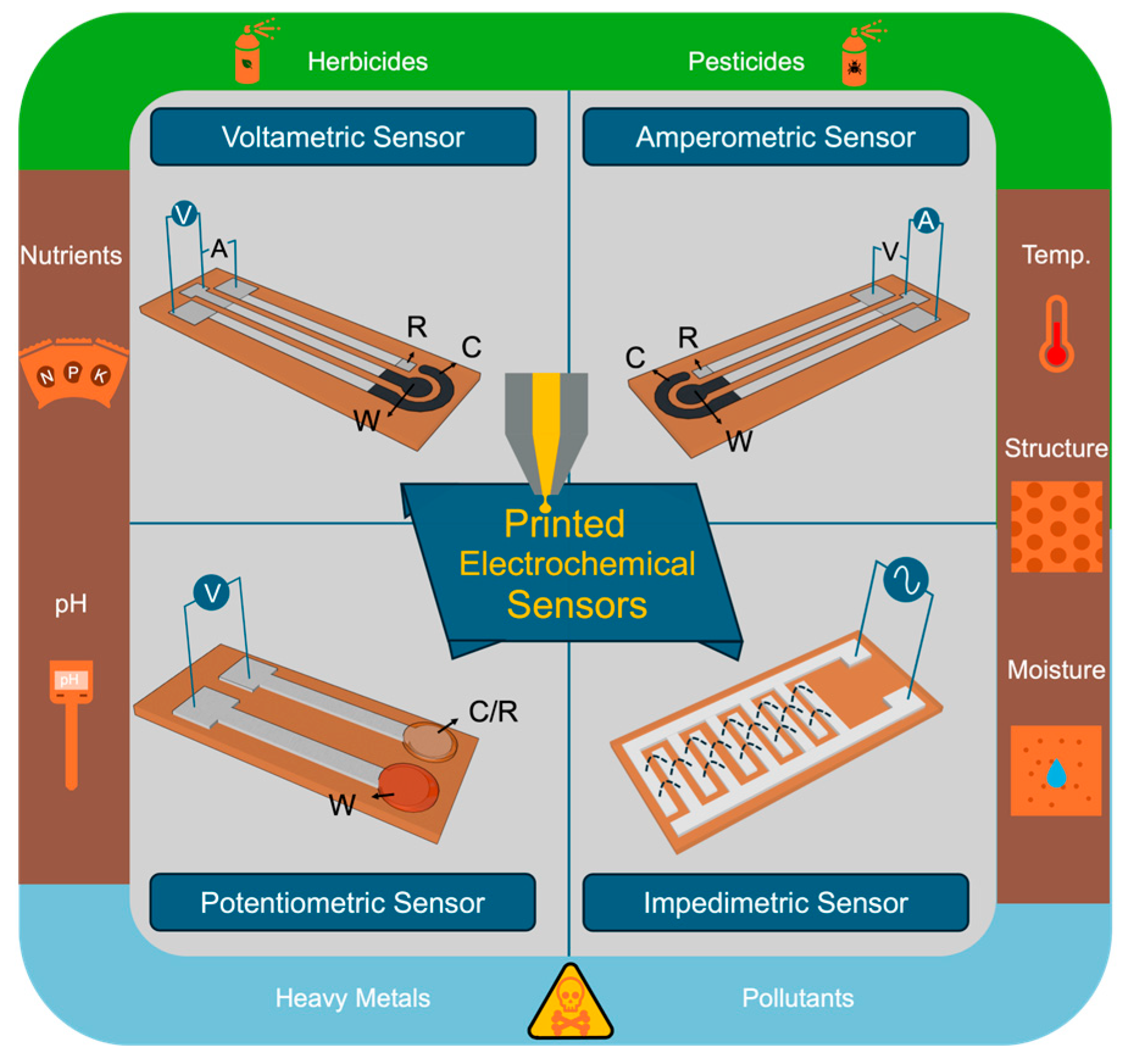
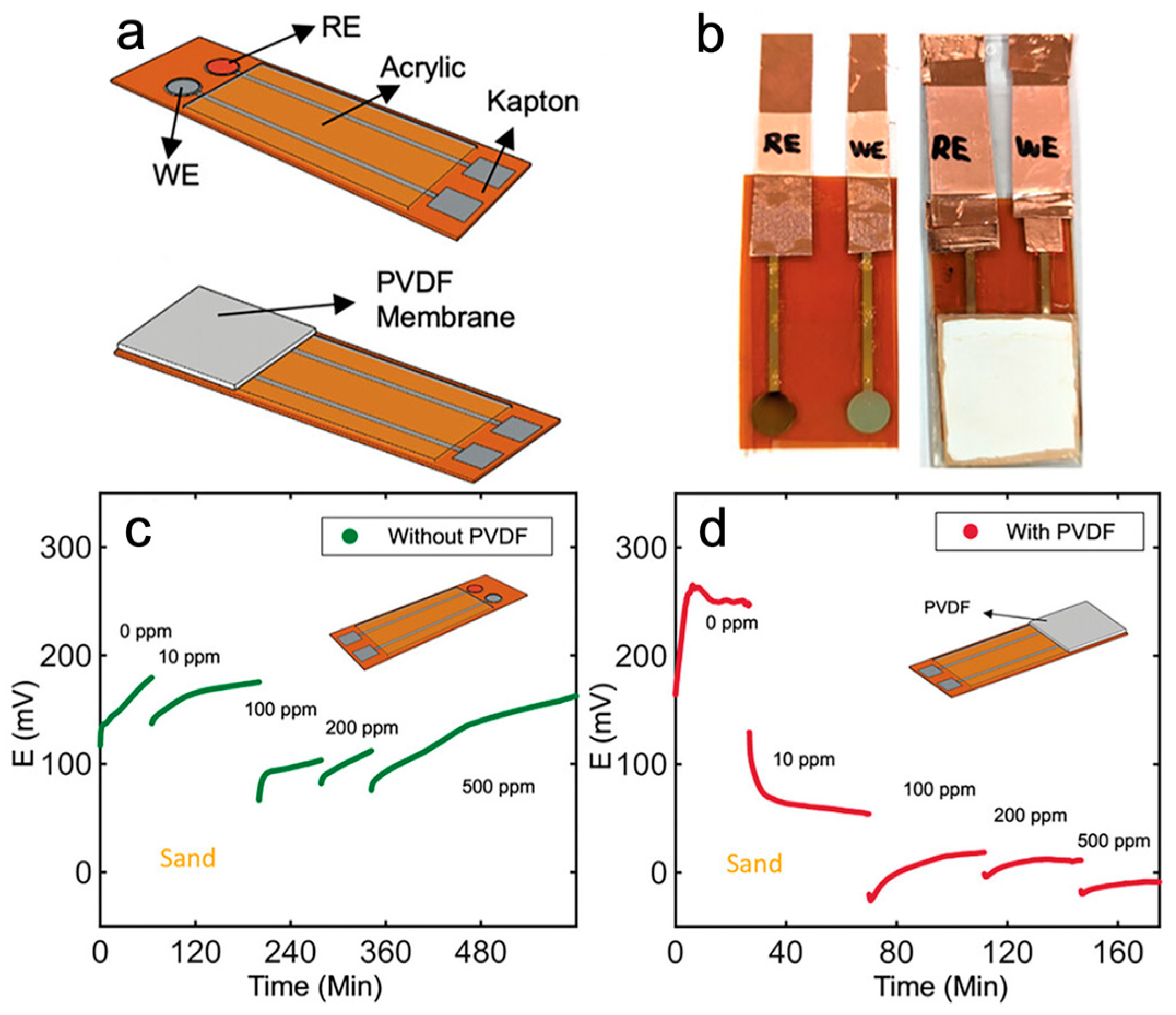

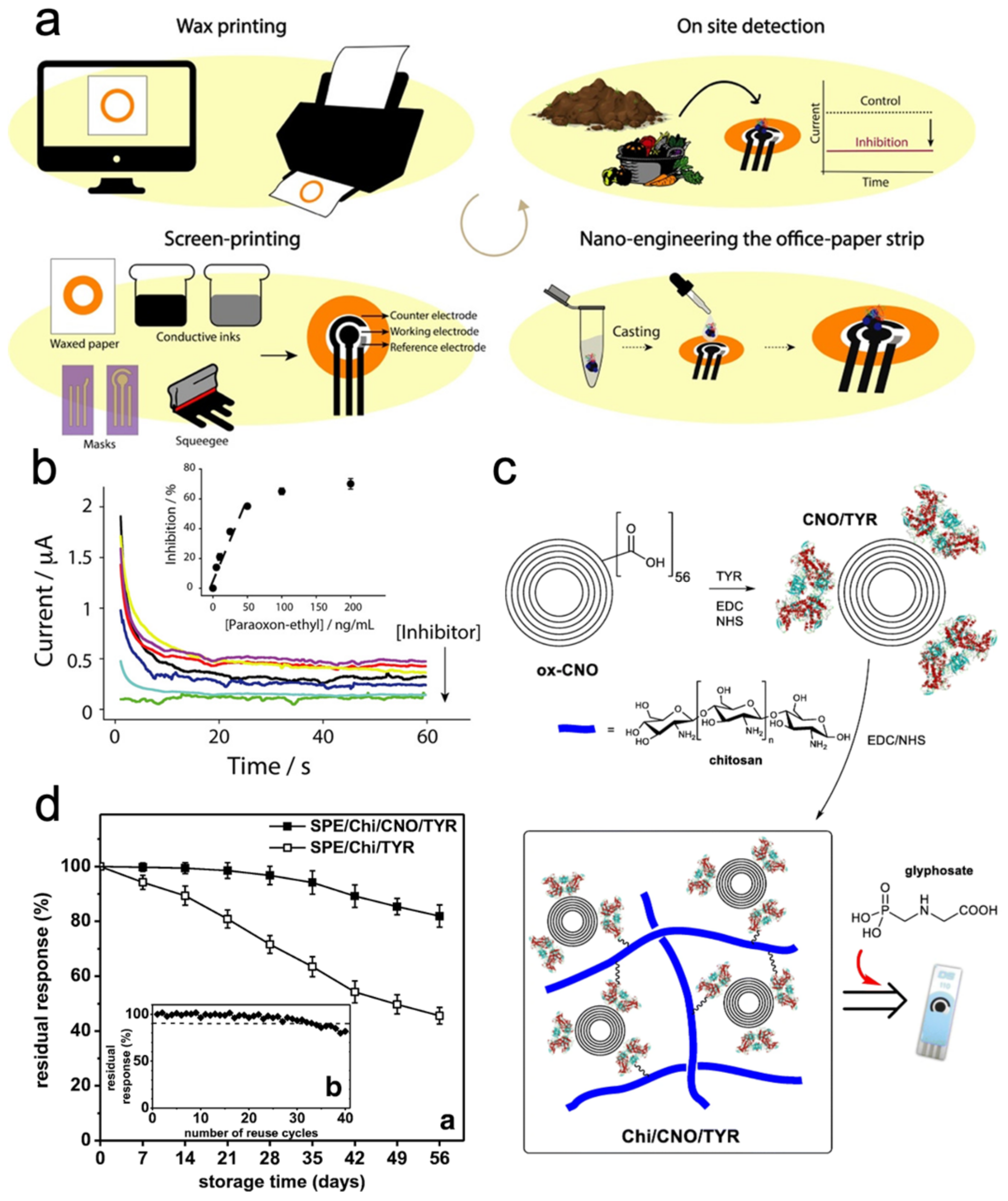

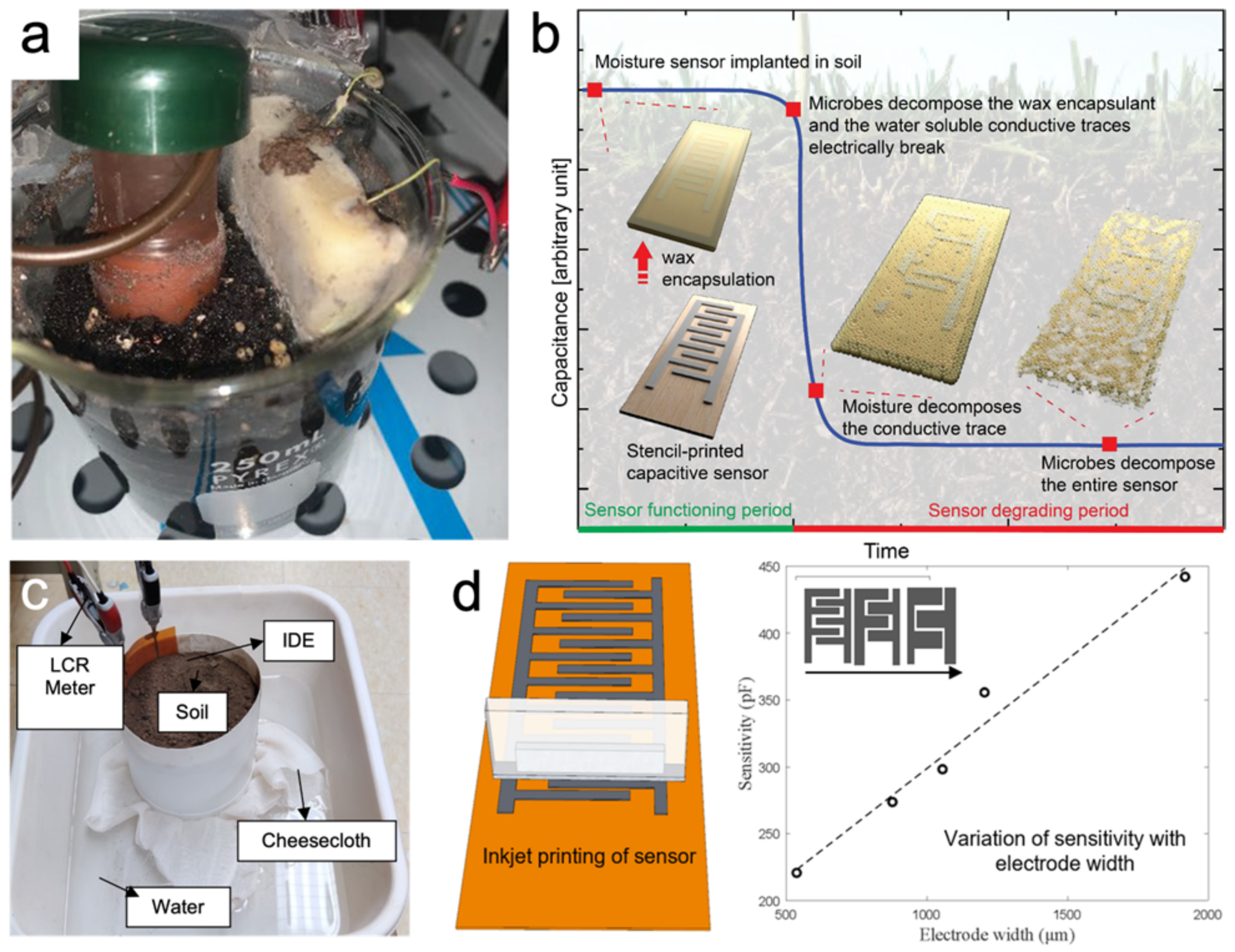
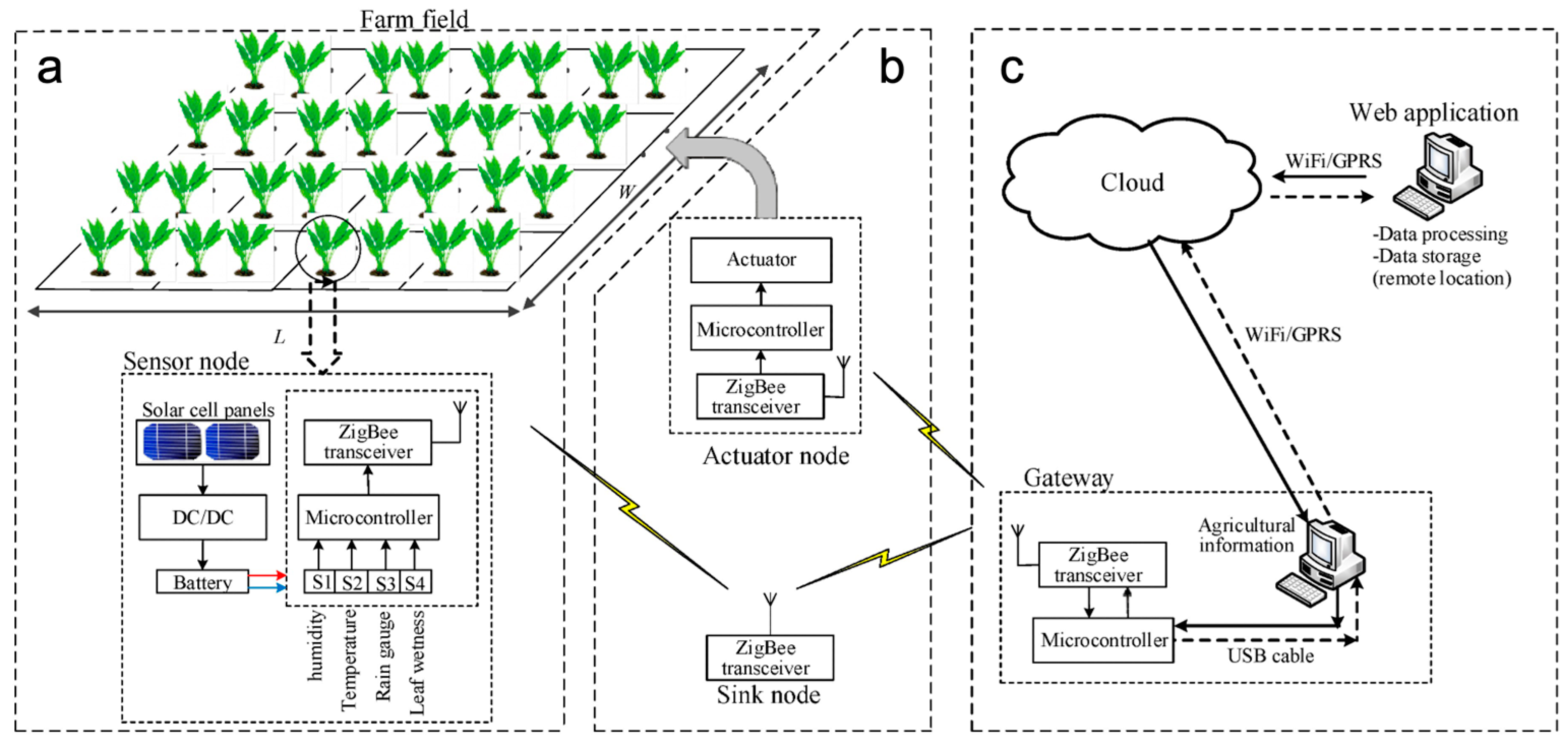
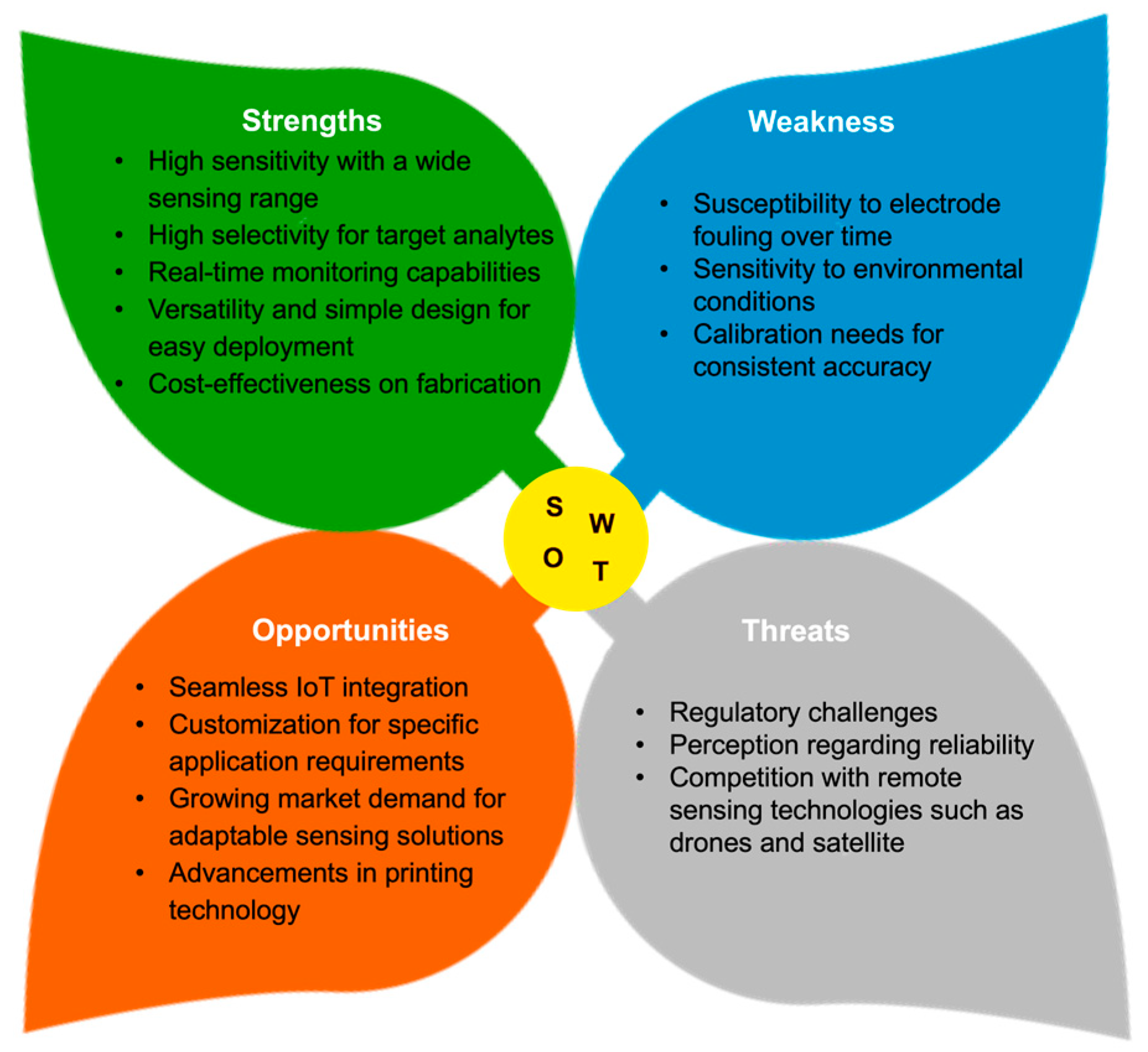
| Printing Techniques/Fabrication Approach | Working Electrode | Functionalization Methods | Target | Soil Test (Moisture) | Sensitivity (mV/dec) | Linear Detection Range (ppm) | LOD (ppm) | Ref. |
|---|---|---|---|---|---|---|---|---|
| Transfer/Laser | Graphene | Nonactin/TCPB/DOS/PVC | Soil Slurry (1:10 w/w) | 51.7 | 0.18 to 1800 | 0.5 | [38] | |
| Catonium MTPB/ nitrocellulose/IPA /NPOE/TDMAN/PVC/THF | −54.8 | 0.62 to 6200 | 1.3 | |||||
| E-beam Deposition Fluid Dispensing | Au POT-MoS2 | Catonium MTPB/ nitrocellulose/IPA /NPOE/TDMAN/PVC/THF | Soil Slurry | −64 | 1 to 1500 | 1.3 | [39] | |
| SPE | Ag | Ag/AgCl | Sterile sandy clay loam soil | −48.6 | 3.55 to 7091 | - | [35] | |
| SPE | Carbon | PVC/NPOE/MIP+PANI | 2,4-D | Orchard soil | 22.08 | 2.21 to 22.10 | 0.1 | [40] |
| IJP | Gold | Nitrate Ionophore VI/PVC/DBP/TBAC/THF | Peat soil (2.8:10 w/w) | −47 | 6.2 to 6200 | 3.1 | [41] | |
| IJP | Ag | TOA-bromide/PVC/plasticizer/THF | Soil (6:10 w/w) | −50~−52 | 62 to 6200 | - | [25] | |
| IJP | Ag/AgCl | NPOE/PVC/TDAN/THF | Sandy soil (4:10 w/w) | −56.29 | 10 to 200 | 8.8 | [26] | |
| Silt loam soil (4:10 w/w) | −46.56 |
| Target Ions | Printing Technique | Functionalization Method | Measurement Method | LOD (ppm) | Linear Detection Range (unit) | RSD | Ref. |
|---|---|---|---|---|---|---|---|
| SPE | CdS-NRs | CV | 0.14 | 3.10–310 | 1.6% | [23] | |
| SPE | BSA/NiR/CNT-α-Fe2O3 | CV | 0.09 | 0.05–500 | 0.43% | [47] | |
| AJP | Ag-Fe2O3/Nafion | CV | - | 1–400 | - | [48] | |
| SPE | MWCNT-CS | CV/Amperometry | 0.11 | 0.74–78.2 | 5.70% | [49] | |
| 3D printing | PLA filament | CV/SWV | 0.09 | 1.15–69 | <7% | [50] | |
| SPE | ZrO2/ZnO/MWCNTs/AMT | CV | 0.0019 | 0.0035–0.1 | 5.80% | [51] | |
| SPE | CBNPs | CV | 0.4 | 0.47–9.5 | 5.30% | [52] | |
| SPE | Prussian blue, carbon black, and butyrylcholinesterase | CV/Chronoamperometry | 0.0013 | 0–0.025 | - | [53] | |
| SPE | Nafion/4-aminobenzo-18-crown-6 ether | CV/DPV | - | 1–500 | 2.45% | [54] | |
| SPE | PEDOT:PSS/KNO3 gel | CV | - | 0.39–390 | - | [24] | |
| Pb2+ | SPE | Au@Py | CV | 0.0006 | 0.0005–0.025 | 4.78% | [55] |
| Pb2+ Cd2+ | SPE | 2% Bi2O3/Graphite carbon ink | CV/Chronopotentiometry | 0.008 0.016 | 0.002–0.3 | 5.60% 9.10% | [56] |
| Cu2+ | SPE | Hg | SWASV | 0.0055 | - | 6% | [57] |
| Hg2+ | SPE | CBNP-AuNPs | SWASV | 0.003 | 0–0.1 | <10% | [58] |
| Cd2+ Pb2+ Cu2+ Hg2+ | SPE | SIM | SWASV | 0.001 0.0002 0.001 0.0002 | 0.02–2.28 0.002–2.07 0.01–1.27 0.002–2.01 | <3% | [59] |
| Pb2+ Cd2+ | SPE | Nafion/Bi film | DPASV | 0.0016 0.0025 | 0–0.08 | 3.5% 3.8% | [60] |
Disclaimer/Publisher’s Note: The statements, opinions and data contained in all publications are solely those of the individual author(s) and contributor(s) and not of MDPI and/or the editor(s). MDPI and/or the editor(s) disclaim responsibility for any injury to people or property resulting from any ideas, methods, instructions or products referred to in the content. |
© 2024 by the authors. Licensee MDPI, Basel, Switzerland. This article is an open access article distributed under the terms and conditions of the Creative Commons Attribution (CC BY) license (https://creativecommons.org/licenses/by/4.0/).
Share and Cite
Chen, K.-Y.; Kachhadiya, J.; Muhtasim, S.; Cai, S.; Huang, J.; Andrews, J. Underground Ink: Printed Electronics Enabling Electrochemical Sensing in Soil. Micromachines 2024, 15, 625. https://doi.org/10.3390/mi15050625
Chen K-Y, Kachhadiya J, Muhtasim S, Cai S, Huang J, Andrews J. Underground Ink: Printed Electronics Enabling Electrochemical Sensing in Soil. Micromachines. 2024; 15(5):625. https://doi.org/10.3390/mi15050625
Chicago/Turabian StyleChen, Kuan-Yu, Jeneel Kachhadiya, Sharar Muhtasim, Shuohao Cai, Jingyi Huang, and Joseph Andrews. 2024. "Underground Ink: Printed Electronics Enabling Electrochemical Sensing in Soil" Micromachines 15, no. 5: 625. https://doi.org/10.3390/mi15050625
APA StyleChen, K.-Y., Kachhadiya, J., Muhtasim, S., Cai, S., Huang, J., & Andrews, J. (2024). Underground Ink: Printed Electronics Enabling Electrochemical Sensing in Soil. Micromachines, 15(5), 625. https://doi.org/10.3390/mi15050625









